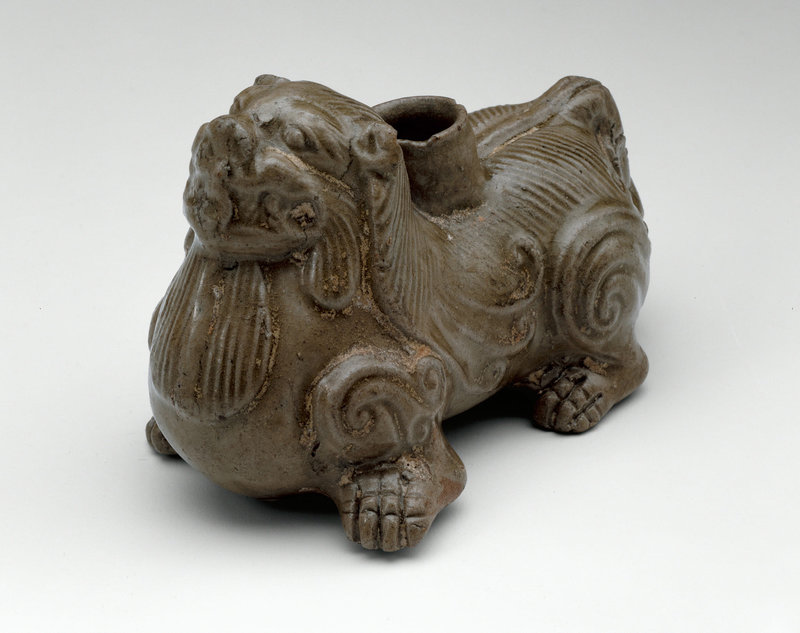Western Jin dynasty Ceramics at The Art Institute of Chicago
Vessel in the Form of a Fantastical Frog, Western Jin dynasty (265–316 AD). Celadon-glazed stoneware with molded decoration, 9.4 × 8.3 cm; Diam.: 8.3 cm. The Art Institute of Chicago, Loan of Dorothy Braude Edinburg Art Properties LLC, 271.2010.
Frog-Shaped Jarlet, Western Jin dynasty (265–316), late 3rd century. Yue ware; stoneware with underglaze molded decoration, 6.4 × 10.6 cm; Diam.: 10.6 cm. The Art Institute of Chicago, Bequest of Russell Tyson, 1964.777.
Stand in the Form of a Crouching Lion, Western Jin dynasty, (265–316), late 3rd century. Yue ware; stoneware with underglaze molded decoration, 7 × 10.6 × 6 cm. The Art Institute of Chicago, Gift of Russell Tyson, 1954.470.
This crouching leonine animal may be a fanciful depiction of a lion—an animal not indigenous to China but initially introduced under the patronage of Buddhism, where it appeared as an emblem for the historical Buddha and as guardian of the faith. This small but imaginative form, carefully modeled with long beard and curled mane, likely served as a candlestand.
Funerary Urn (Hunping), Western Jin dynasty (A.D. 265–316), late 3rd century. Stoneware with olive-green glaze and molded and applied decoration, 48.7 × 27.5 cm; Diam.: 27.5 cm. The Art Institute of Chicago, Through prior bequests of Mary Hooker Dole and Grace Brown Palmer; through prior gifts of Josephine P. Albright in memory of Alice Higinbotham Patterson, and Mrs. Kent S. Clow; Russell Tyson, Robert C. Ross endowments, 1987.242.
This complex and imaginatively modeled vessel is known as an “urn of the soul,” a symbolic dwelling for the spirit of the deceased. A profusion of figures was molded and applied to its sealed lid, which takes the form of a multistory pavilion. In the balcony-like mouth-rim, a tortoise supports a large vertical tablet, a common form of memorial stone. The real and mythical creatures on the vessel—birds, monkeys, bears, dragons, kneeling figures, and immortals riding dragons—all follow the iconography of early Chinese funerary art. Intermingled with these images, however, are depictions of the Buddha, who is identified by his meditating posture, topknot, and halo. The marginal role of Buddhist art in this decorative scheme reflects the adoption of the alien Indian religion, as the Chinese then understood it, into a hospitable mélange of different spiritual beliefs. Additionally, this jar reflects a formative stage in the development of China’s renowned celadon glaze, which became more uniform in color and texture over subsequent centuries.

/https%3A%2F%2Fprofilepics.canalblog.com%2Fprofilepics%2F1%2F0%2F100183.jpg)
/https%3A%2F%2Fstorage.canalblog.com%2F03%2F02%2F119589%2F96711876_o.jpg)
/https%3A%2F%2Fstorage.canalblog.com%2F11%2F31%2F119589%2F94773502_o.jpg)
/https%3A%2F%2Fstorage.canalblog.com%2F20%2F83%2F119589%2F94772815_o.jpg)
/https%3A%2F%2Fstorage.canalblog.com%2F26%2F72%2F119589%2F75604929_o.jpg)
/https%3A%2F%2Fstorage.canalblog.com%2F59%2F60%2F119589%2F26458628_o.jpg)







/http%3A%2F%2Fstorage.canalblog.com%2F74%2F67%2F119589%2F126989462_o.jpg)
/image%2F1371349%2F20240423%2Fob_b2fe42_telechargement-9.jpg)
/image%2F1371349%2F20240423%2Fob_af8bb4_telechargement-6.jpg)
/image%2F1371349%2F20240423%2Fob_b6c4a6_telechargement.jpg)